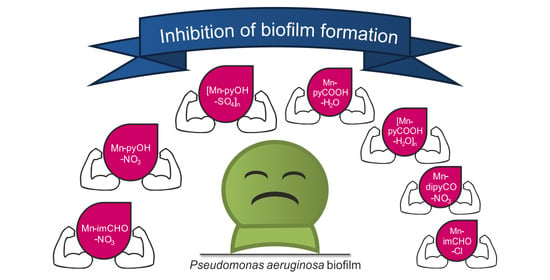Tuning Anti-Biofilm Activity of Manganese(II) Complexes: Linking Biological Effectiveness of Heteroaromatic Complexes of Alcohol, Aldehyde, Ketone, and Carboxylic Acid with Structural Effects and Redox Activity
Abstract
1. Introduction
2. Results and Discussion
2.1. Synthesis and Characterization of Mn-dipyCO-NO3
2.2. Description of the Molecular and Crystal Structure
2.3. Hirshfeld Surface Analysis of the Series Mn(II) Complexes
2.4. Electrochemical Studies (CV and DPV Methods)
2.5. Antimicrobial Activity
2.5.1. Antibacterial Activity
2.5.2. Antibiofilm Activity
2.5.3. The Effect of Mn(II) Complexes on Pyoverdine Production
2.6. Cytotoxicity Activity
2.7. Effect of Mn(II) Complexes on Catalase Activity
2.8. Structure–Activity (Anti-Biofilm Activity) Relationship
2.9. Regularity between Electrochemical Properties and Anti-Biofilm Activity
3. Materials and Methods
3.1. Antimicrobial Assays
3.2. Pyoverdine Production by Pseudomonas aeruginosa
3.3. Cytotoxicity Activity (MTT Test)
3.4. Cytotoxicity Activity (DHI Assay)
3.5. Catalase Activity Study in the Presence of the Mn(II) Complexes
3.6. Statistical Analysis
4. Conclusions
- -
- The first one regards the induction of oxidative stress in bacterial cells by the inhibition effect on the CAT enzyme;
- -
- The other one is connected with the participation of the complexes in the disturbance of adhesion of bacterial cells (supramolecular interactions).
Supplementary Materials
Author Contributions
Funding
Institutional Review Board Statement
Informed Consent Statement
Data Availability Statement
Acknowledgments
Conflicts of Interest
References
- Prestinaci, F.; Pezzotti, P.; Pantosti, A. Antimicrobial resistance: A global multifaceted phenomenon. Pathog. Glob. Heal. 2015, 109, 309–318. [Google Scholar] [CrossRef] [PubMed]
- Jefferson, K.K. What drives bacteria to produce a biofilm? FEMS Microbiol. Lett. 2004, 236, 163–173. [Google Scholar] [CrossRef]
- Patel, I.; Patel, V.; Thakkar, A.; Kothari, V. Microbial Biofilms: Microbes in Social Mode. Int. J. Agric. Food Res. 2014, 3, 34–49. [Google Scholar] [CrossRef]
- Algburi, A.; Comito, N.; Kashtanov, D.; Dicks, L.M.T.; Chikindas, M.L. Control of Biofilm Formation: Antibiotics and Beyond. Appl. Environ. Microbiol. 2017, 83, 1–16. [Google Scholar] [CrossRef]
- Alhazmi, A. Pseudomonas aeruginosa—Pathogenesis and Pathogenic Mechanisms. Int. J. Biol. 2015, 7, 44–67. [Google Scholar] [CrossRef]
- Lei, J.; Sun, L.; Huang, S.; Zhu, C.; Li, P.; He, J.; Mackey, V.; Coy, D.H.; He, Q. The antimicrobial peptides and their potential clinical applications. Am. J. Transl. Res. 2019, 11, 3919–3931. [Google Scholar] [PubMed]
- Raheem, N.; Straus, S.K. Mechanisms of Action for Antimicrobial Peptides with Antibacterial and Antibiofilm Functions. Front. Microbiol. 2019, 10, 2866. [Google Scholar] [CrossRef]
- Hancock, R.E.W.; Sahl, H.G. Antimicrobial and host-defense peptides as new anti-infective therapeutic strategies. Nat. Biotechnol. 2006, 24, 1551–1557. [Google Scholar] [CrossRef] [PubMed]
- Yarlagadda, V.; Akkapeddi, P.; Manjunath, G.B.; Haldar, J. Membrane Active Vancomycin Analogues: A Strategy to Combat Bacterial Resistance. J. Med. Chem. 2014, 57, 4558–4568. [Google Scholar] [CrossRef]
- Parrino, B.; Schillaci, D.; Carnevale, I.; Giovannetti, E.; Diana, P.; Cirrincione, G.; Cascioferro, S. Synthetic small molecules as anti-biofilm agents in the struggle against antibiotic resistance. Eur. J. Med. Chem. 2019, 161, 154–178. [Google Scholar] [CrossRef]
- Rabin, N.; Zheng, Y.; Opoku-Temeng, C.; Du, Y.; Bonsu, E.; Sintim, H.O. Agents that inhibit bacterial biofilm formation. Futur. Med. Chem. 2015, 7, 647–671. [Google Scholar] [CrossRef] [PubMed]
- Festa, R.A.; Helsel, M.E.; Franz, K.J.; Thiele, D.J. Exploiting Innate Immune Cell Activation of a Copper-Dependent Antimicrobial Agent during Infection. Chem. Biol. 2014, 21, 977–987. [Google Scholar] [CrossRef] [PubMed]
- Djoko, K.Y.; Goytia, M.M.; Donnelly, P.S.; Schembri, M.A.; Shafer, W.M.; McEwan, A.G. Copper(II)-Bis(Thiosemicarbazonato) Complexes as Antibacterial Agents: Insights into Their Mode of Action and Potential as Therapeutics. Antimicrob. Agents Chemother. 2015, 59, 6444–6453. [Google Scholar] [CrossRef] [PubMed]
- Frei, A.; Zuegg, J.; Elliott, A.G.; Baker, M.V.; Braese, S.; Brown, C.; Chen, F.; Dowson, C.G.; Dujardin, G.; Jung, N.; et al. Metal complexes as a promising source for new antibiotics. Chem. Sci. 2020, 11, 2627–2639. [Google Scholar] [CrossRef] [PubMed]
- Claudel, M.; Schwarte, J.V.; Fromm, K.M. New Antimicrobial Strategies Based on Metal Complexes. Chemistry 2020, 2, 849–899. [Google Scholar] [CrossRef]
- Medici, S.; Peana, M.; Nurchi, V.M.; Lachowicz, J.I.; Crisponi, G.; Zoroddu, M.A. Noble metals in medicine: Latest advances. Coord. Chem. Rev. 2015, 284, 329–350. [Google Scholar] [CrossRef]
- Ndagi, U.; Mhlongo, N.; Soliman, M.E. Metal complexes in cancer therapy–an update from drug design perspective. Drug Des. Dev. Ther. 2017, 11, 599–616. [Google Scholar] [CrossRef]
- Liu, W.; Gust, R. Update on metal N-heterocyclic carbene complexes as potential anti-tumor metallodrugs. Coord. Chem. Rev. 2016, 329, 191–213. [Google Scholar] [CrossRef]
- Martinez-Finley, E.J.; Chakraborty, S.; Aschner, M. Manganese in biological systems. In Encyclopedia of Metalloproteins; Kretsinger, R.H., Uversky, V.N., Permyakov, E.A., Eds.; Springer: New York, NY, USA, 2013; pp. 1297–1303. ISBN 978-1-4614-1532-9. [Google Scholar]
- Ali, B.; Iqbal, M.A. Coordination Complexes of Manganese and Their Biomedical Applications. ChemistrySelect 2017, 2, 1586–1604. [Google Scholar] [CrossRef]
- Jayakumar, S.; Mahendiran, D.; Srinivasan, T.; Mohanraj, G.; Kalilur Rahiman, A. Theoretical investigation, biological evaluation and VEGFR2 kinase studies of metal(II) complexes derived from hydrotris(methimazolyl)borate. J. Photochem. Photobiol. B Biol. 2016, 155, 66–77. [Google Scholar] [CrossRef]
- Wang, J.; Wang, Q.L.; Nong, X.H.; Zhang, X.Y.; Xu, X.Y.; Qi, S.H.; Wang, Y.F. Oxalicumone A, a new dihydrothiophene-condensed sulfur chromone induces apoptosis in leukemia cells through endoplasmic reticulum stress pathway. Eur. J. Pharmacol. 2016, 783, 47–55. [Google Scholar] [CrossRef]
- Rai, M.; Ingle, A.P.; Paralikar, P. Sulfur and sulfur nanoparticles as potential antimicrobials: From traditional medicine to nanomedicine. Expert Rev. Antiinfect. Ther. 2016, 14, 969–978. [Google Scholar] [CrossRef] [PubMed]
- Heravi, M.M.; Zadsirjan, V. Prescribed drugs containing nitrogen heterocycles: An overview. RSC Adv. 2020, 10, 44247–44311. [Google Scholar] [CrossRef]
- Zhang, L.; Peng, X.M.; Damu, G.L.V.; Geng, R.X.; Zhou, C.H. Comprehensive Review in Current Developments of Imidazole-Based Medicinal Chemistry. Med. Res. Rev. 2014, 34, 340–437. [Google Scholar] [CrossRef]
- Siwach, A.; Verma, P.K. Synthesis and therapeutic potential of imidazole containing compounds. BMC Chem. 2021, 15, 1–69. [Google Scholar] [CrossRef] [PubMed]
- Shalini, K.; Sharma, P.K.; Kumar, N. Imidazole and its biological activities: A review. Der Chem. Sin. 2010, 1, 36–47. [Google Scholar]
- Chaubey, A.; Pandeya, S.N. Pyridine a versatile nucleuse in pharmaceutical field. Asian J. Pharm. Clin. Res. 2011, 4, 5–8. [Google Scholar]
- Jabłońska-Wawrzycka, A.; Barszcz, B.; Zienkiewicz, M.; Hodorowicz, M.; Jezierska, J.; Stadnicka, K.; Lechowicz, Ł.; Kaca, W. Eight- and six-coordinated Mn(II) complexes of heteroaromatic alcohol and aldehyde: Crystal structure, spectral, magnetic, thermal and antibacterial activity studies. Spectrochim. Acta Part A Mol. Biomol. Spectrosc. 2014, 129, 632–642. [Google Scholar] [CrossRef] [PubMed]
- Jabłońska-Wawrzycka, A.; Zienkiewicz, M.; Barszcz, B.; Rogala, P. Thermoanalytical study of selected transition bivalent metal complexes with 5-carbaldehyde-4-methylimidazole. J. Therm. Anal. Calorim. 2012, 109, 735–743. [Google Scholar] [CrossRef]
- Zienkiewicz, M.; Szlachetko, J.; Lothschütz, C.; Hodorowicz, M.; Jabłońska-Wawrzycka, A.; Sá, J.; Barszcz, B. A novel single-site manganese(II) complex of a pyridine derivative as a catalase mimetic for disproportionation of H2O2 in water. Dalton Trans. 2013, 42, 7761. [Google Scholar] [CrossRef]
- Zienkiewicz, M.; Jabłońska-Wawrzycka, A.; Szlachetko, J.; Kayser, Y.; Stadnicka, K.; Sawka-Dobrowolska, W.; Jezierska, J.; Barszcz, B.; Sá, J. Effective catalytic disproportionation of aqueous H2O2 with di- and mono-nuclear manganese(II) complexes containing pyridine alcohol ligands. Dalton Trans. 2014, 43, 8599–8608. [Google Scholar] [CrossRef]
- Jabłońska-Wawrzycka, A.; Zienkiewicz, M.; Hodorowicz, M.; Rogala, P.; Barszcz, B. Thermal behavior of manganese(II) complexes with pyridine-2,3-dicarboxylic acid. J. Therm. Anal. Calorim. 2012, 110, 1367–1376. [Google Scholar] [CrossRef]
- Kleywegt, G.J.; Wiesmeijer, W.G.R.; Van Driel, G.J.; Driessen, W.L.; Reedijk, J.; Noordik, J.H. Unidentate versus symmetrically and unsymmetrically bidentate nitrate co-ordination in pyrazole-containing chelates. The crystal and molecular structures of (nitrato-O)[tris(3,5-dimethylpyrazol-1-ylmethyl)amine]copper(II) nitrate, (nitrato-O,O′)[tris(3,5-dimethylpyrazol-1-ylmethyl)amine]nickel(II) nitrate, and (nitrato-O)(nitrato-O,O′)[tris(3,5-dimethylpyrazol-1-ylmethyl)amine]cadmium(II). J. Chem. Soc. Dalton Trans. 1985, 53, 2177–2184. [Google Scholar] [CrossRef]
- Diamantopoulou, E.; Zafiropoulos, T.F.; Perlepes, S.P.; Raptopoulou, C.P.; Terzis, A. Synthetic and structural chemistry of nickel(II)/1-methylbenzotriazole complexes. Polyhedron 1994, 13, 1593–1608. [Google Scholar] [CrossRef]
- Nakamoto, K. Infrared and Raman Spectra of Inorganic and Coordination Compounds Part B: Applications in Coordination, Organometallic, and Bioinorganic Chemistry, 6th ed.; John Wiley & Sons, Inc.: Hoboken, NJ, USA, 2009. [Google Scholar]
- Lever, A.B.P.; Mantovani, E.; Ramaswamy, B.S. Infrared Combination Frequencies in Coordination Complexes containing Nitrate Groups in various Coordination Environments. A Probe for the Metal–Nitrate Interaction. Can. J. Chem. 1971, 49, 1957–1964. [Google Scholar] [CrossRef]
- Powder Diffraction File; File No 40-1290; JCPDS, ICDD: Swarthmore, PA, USA, 1990.
- Kanaras, C.; Westcott, B.L.; Crundwell, G.; Updegraff, J.B.; Zeller, M.; Hunter, A.D.; Sommerer, S.O. Crystal structures of (di-2-pyridyl ketone)zinc dibromide and diiodide, Zn(C11H8N-O)X2 (X = Br,I). Z. Kristallogr. New Cryst. Struct. 2004, 219, 425–426. [Google Scholar] [CrossRef]
- Crowder, K.N.; Garcia, S.J.; Burr, R.L.; North, J.M.; Wilson, M.H.; Conley, B.L.; Fanwick, P.E.; White, P.S.; Sienerth, K.D.; Granger, R.M. Synthesis of Pt(dpk)Cl4 and the Reversible Hydration to Pt(dpk-O-OH)Cl3·H-phenCl: X-ray, Spectroscopic, and Electrochemical Characterization. Inorg. Chem. 2004, 43, 72–78. [Google Scholar] [CrossRef] [PubMed]
- Zhang, F.; Prokopchuk, E.M.; Broczkowski, M.E.; Jennings, M.C.; Puddephatt, R.J. Hydridodimethylplatinum(IV) Complexes with Bis(pyridine) Ligands: Effect of Chelate Ring Size on Reactivity. Organometallics 2006, 25, 1583–1591. [Google Scholar] [CrossRef]
- Sarkar, S.; Sarkar, B.; Chanda, N.; Kar, S.; Mobin, S.M.; Fiedler, J.; Kaim, W.; Lahiri, G.K. Complex Series [Ru(tpy)(dpk)(X)]n+ (tpy = 2,2‘:6‘,2‘‘-Terpyridine; dpk = 2,2‘-Dipyridyl Ketone; X = Cl-, CH3CN, NO2-, NO+, NO•, NO-): Substitution and Electron Transfer, Structure, and Spectroscopy. Inorg. Chem. 2005, 44, 6092–6099. [Google Scholar] [CrossRef]
- Yang, G.; Zheng, S.L.; Chen, X.M.; Lee, H.K.; Zhou, Z.Y.; Mak, T.C. Systematic study of synthesis and crystal structures of Ag(DPK)nX complexes (DPK=di-2-pyridyl ketone; X=NO2−, ClO4−, ClO3−, PF6−, n=1; X=ClO4−, ClO3−, n=2): Role of anion and π–π stacking interaction. Inorg. Chim. Acta 2000, 303, 86–93. [Google Scholar] [CrossRef]
- Deelman, B.J.; Stevels, W.M.; Teuben, J.H.; Lakin, M.T.; Spek, A.L. Insertion Chemistry of Yttrium Complex Cp*2Y(2-pyridyl) and Molecular Structure of an Unexpected CO Insertion Product (Cp*2Y)2(μ-η2:η2-OC(NC5H4)2). Organometallics 1994, 13, 3881–3891. [Google Scholar] [CrossRef]
- Godard, C.; Duckett, S.B.; Parsons, S.; Perutz, R.N. Dipyridylketone binding and subsequent C-C bond insertion reactions at cyclopentadienylrhodium. Chem. Commun. 2003, 2332–2333. [Google Scholar] [CrossRef] [PubMed]
- Toyama, M.; Nakahara, M.; Nagao, N. Syntheses, Crystal Structures, and Conversion of Three Linkage Isomers of Di-2-pyridyl Ketone in Dichlorobis(dimethyl sulfoxide-S)ruthenium(II) and Chlorobis(dimethyl sulfoxide-S)ruthenium(II) Complexes: [RuCl2(dpk-κ2N,O)(dmso-S)2], [RuCl2(dpk-κ2N,N′)(dmso-S)2], and [RuCl(dpk-OH-κ3N,O,N′)(dmso-S)2]. Bull. Chem. Soc. Jpn. 2007, 80, 937–950. [Google Scholar] [CrossRef]
- Ito, M.; Onaka, S. Versatility of pyridine-2-methanol as a chelating ligand toward a manganese ion: Synthesis and X-ray structural analysis on some manganese-pyridine-2-methanol derivatives. Inorg. Chim. Acta 2004, 357, 1039–1046. [Google Scholar] [CrossRef]
- Małecki, J.G.; Machura, B.; Świtlicka, A.; GroŃ, T.; Bałanda, M. Thiocyanate manganese(II) complexes with pyridine and its derivatives ligands. Polyhedron 2011, 30, 746–753. [Google Scholar] [CrossRef]
- Spackman, M.A.; Jayatilaka, D. Hirshfeld surface analysis. CrystEngComm 2009, 11, 19–32. [Google Scholar] [CrossRef]
- Marken, F.; Neudeck, A.; Bond, A.M.; Stojek, Z. Cyclic Voltammetry; Pulse Voltammetry. In Electroanalytical Methods. Guide to Experiments and Applications; Scholz, F., Ed.; Springer: Berlin/Heidelberg, Germany, 2010; pp. 57–119. ISBN 978-3-642-02914-1. [Google Scholar]
- Paul, P.; Tyagi, B.; Bilakhiya, A.K.; Bhadbhade, M.M.; Suresh, E.; Ramachandraiah, G. Synthesis and Characterization of Rhodium Complexes Containing 2,4,6-Tris(2-pyridyl)-1,3,5-triazine and Its Metal-Promoted Hydrolytic Products: Potential Uses of the New Complexes in Electrocatalytic Reduction of Carbon Dioxide. Inorg. Chem. 1998, 37, 5733–5742. [Google Scholar] [CrossRef]
- Bakir, M.; McKenzie, J.A.M. Electrochemical reactions of CO2 with fac-Re(dpk)(CO)3Cl (dpk = di-2-pyridyl ketone). J. Electroanal. Chem. 1997, 425, 61–66. [Google Scholar] [CrossRef]
- Bakir, M.; McKenzie, J.A.M. Rhenium(I) di- and tri-carbonyl compounds of polypyridyl-like ligands: Electrochemical reactions of fac-[Re(CO)3(dpk)Cl] (dpk = di-2-pyridyl ketone) with electrophiles and Group I and II metal ions. J. Chem. Soc. Dalton Trans. 1997, 3, 3571–3578. [Google Scholar] [CrossRef]
- Tong, M.L.; Lee, H.K.; Tong, Y.X.; Chen, X.M.; Mak, T.C.W. An Octanuclear Copper(II) Complex Containing the gem-Diol Anionic Form of Di-2-pyridyl Ketone (dpd-2H) and 2-Hydroxypyridine: Synthesis, Crystal Structure, and Properties of [Cu8(dpd-2H)4(μ2-O2CMe)4{2-(OH)C5H4N}4]- (ClO4)4·4H2O. Inorg. Chem. 2000, 39, 4666–4669. [Google Scholar] [CrossRef]
- Aleksic, I.; Petkovic, M.; Jovanovic, M.; Milivojevic, D.; Vasiljevic, B.; Nikodinovic-Runic, J.; Senerovic, L. Anti-biofilm Properties of Bacterial Di-Rhamnolipids and Their Semi-Synthetic Amide Derivatives. Front. Microbiol. 2017, 8, 2454. [Google Scholar] [CrossRef]
- Croft, L.V.; Mulders, J.A.; Richard, D.J.; O’Byrne, K. Digital Holographic Imaging as a Method for Quantitative, Live Cell Imaging of Drug Response to Novel Targeted Cancer Therapies. In Theranostics. Methods in Molecular Biology; Batra, J., Srinivasan, S., Eds.; Human Press: New York, NY, USA, 2019; Volume 2054, pp. 171–183. [Google Scholar] [CrossRef]
- Zhang, Y.; Judson, R.L. Evaluation of holographic imaging cytometer holomonitor M4® motility applications. Cytom. Part A 2018, 93, 1125–1131. [Google Scholar] [CrossRef]
- Ma, X.; Deng, D.; Chen, W. Inhibitors and Activators of SOD, GSH-Px, and CAT. In Enzyme Inhibitors and Activators; Şentürk, M., Ed.; InTechOpen: Rijeka, Croatia, 2017; pp. 207–224. ISBN 978-953-51-3058-1. [Google Scholar]
- McKinney, J.D.; Richard, A.; Waller, C.; Newman, M.C.; Gerberick, F. The Practice of Structure Activity Relationships (SAR) in Toxicology. Toxicol. Sci. 2000, 56, 8–17. [Google Scholar] [CrossRef] [PubMed]
- Patel, N.B.; Agravat, S.N.; Shaikh, F.M. Synthesis and antimicrobial activity of new pyridine derivatives-I. Med. Chem. Res. 2011, 20, 1033–1041. [Google Scholar] [CrossRef]
- Otwinowski, Z.; Minor, W. Processing of X-ray diffraction data collected in oscillation mode. Methods in Enzymology 1997, 276, 307–326. [Google Scholar] [CrossRef] [PubMed]
- De Abreu, F.C.; De Ferraz, P.A.L.; Goulart, M.O.F. Some Applications of Electrochemistry in Biomedical Chemistry. Emphasis on the Correlation of Electrochemical and Bioactive Properties. J. Braz. Chem. Soc. 2002, 13, 19–35. [Google Scholar] [CrossRef]
- Dryhurst, G.; Stocker, J.H. Electrochemistry of Biological Molecules. J. Electrochem. Soc. 1977, 124, 390C. [Google Scholar] [CrossRef]
- Rogala, P.; Czerwonka, G.; Michałkiewicz, S.; Hodorowicz, M.; Barszcz, B.; Jabłońska-Wawrzycka, A. Synthesis, Structural Characterization and Antimicrobial Evaluation of Ruthenium Complexes with Heteroaromatic Carboxylic Acids. Chem. Biodivers. 2019, 16, e1900403. [Google Scholar] [CrossRef]
- Czerwonka, G.; Guzy, A.; Kałuża, K.; Grosicka, M.; Dańczuk, M.; Lechowicz, Ł.; Gmiter, D.; Kowalczyk, P.; Kaca, W. The role of Proteus mirabilis cell wall features in biofilm formation. Arch. Microbiol. 2016, 198, 877–884. [Google Scholar] [CrossRef]
- Czerwonka, G.; Gmiter, D.; Guzy, A.; Rogala, P.; Jabłońska-Wawrzycka, A.; Borkowski, A.; Cłapa, T.; Narożna, D.; Kowalczyk, P.; Syczewski, M.; et al. A benzimidazole-based ruthenium(IV) complex inhibits Pseudomonas aeruginosa biofilm formation by interacting with siderophores and the cell envelope, and inducing oxidative stress. Biofouling 2019, 35, 59–74. [Google Scholar] [CrossRef]
- Zhang, H.; Liu, C.S.; Bu, X.H.; Yang, M. Synthesis, crystal structure, cytotoxic activity and DNA-binding properties of the copper(II) and zinc(II) complexes with 1-[3-(2-pyridyl)pyrazol-1-ylmethyl]naphthalene. J. Inorg. Biochem. 2005, 99, 1119–1125. [Google Scholar] [CrossRef] [PubMed]

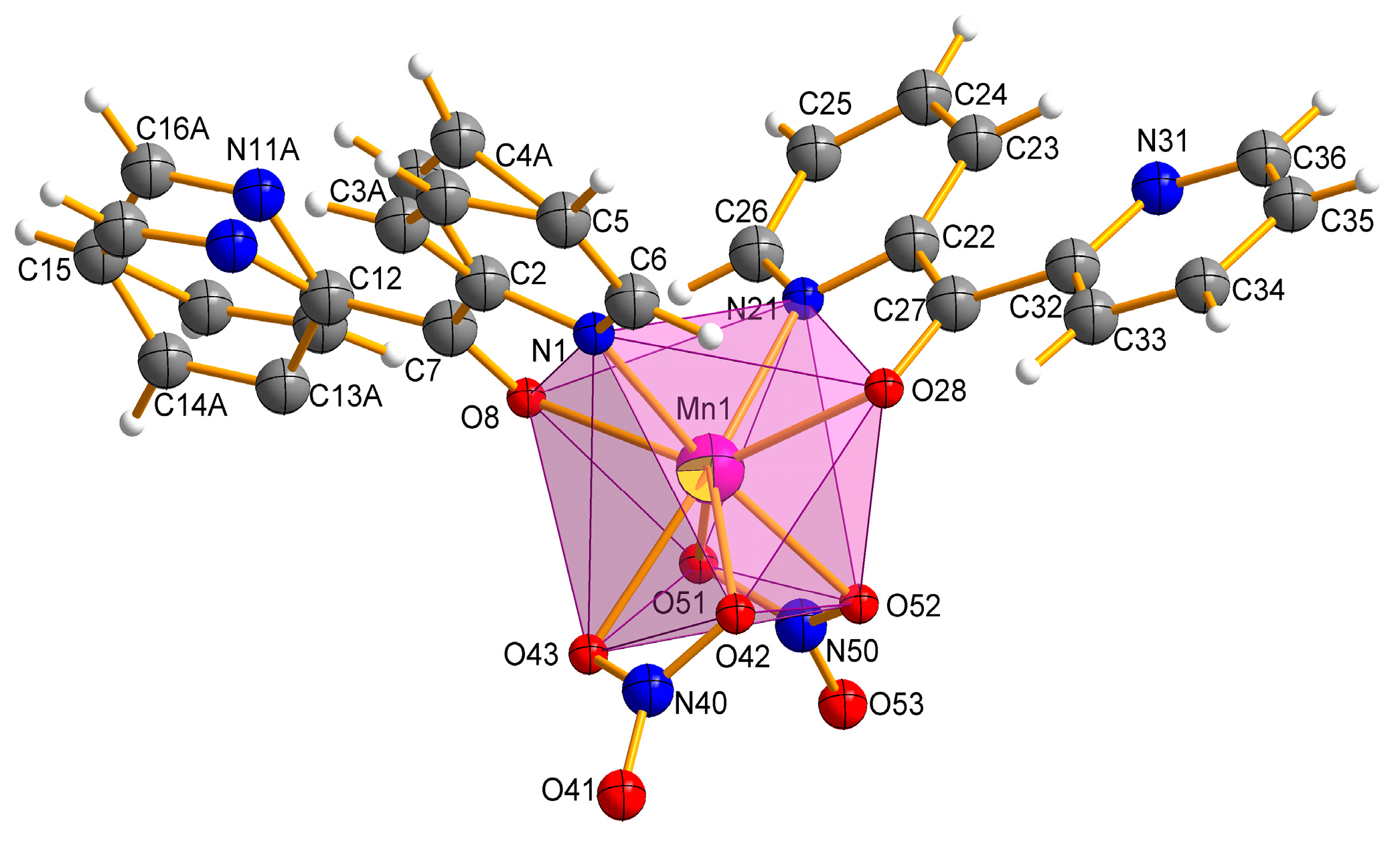
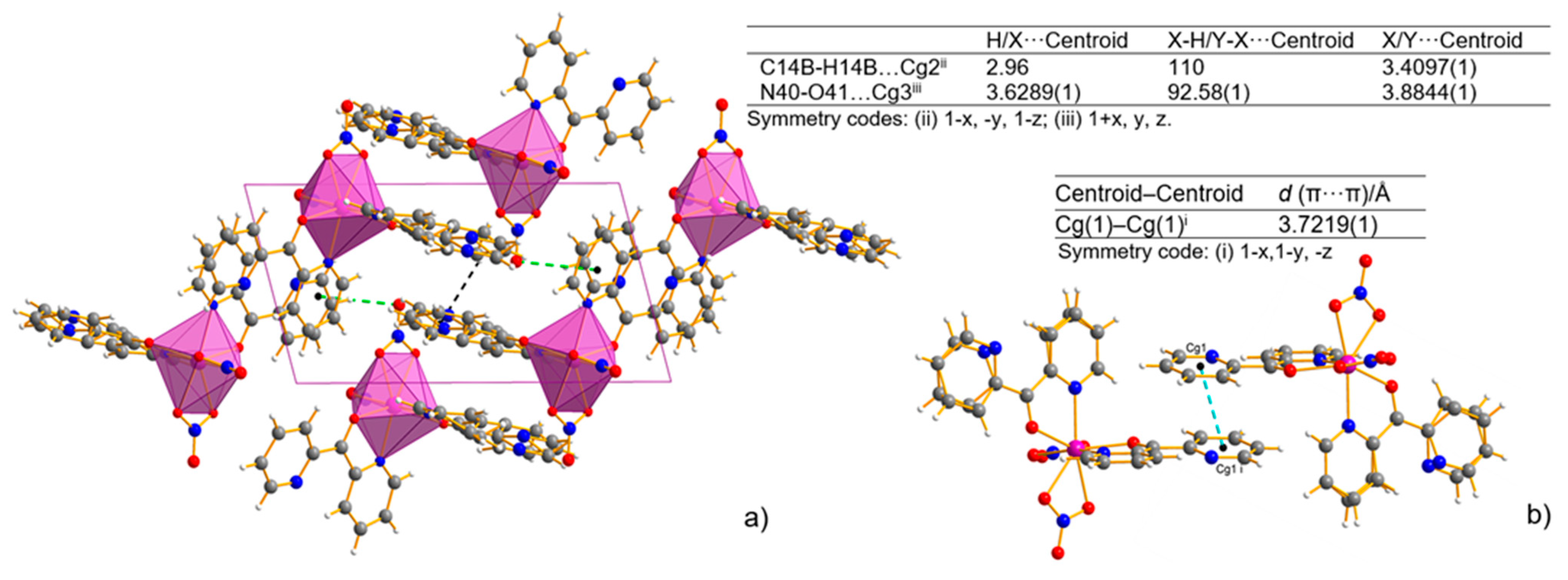
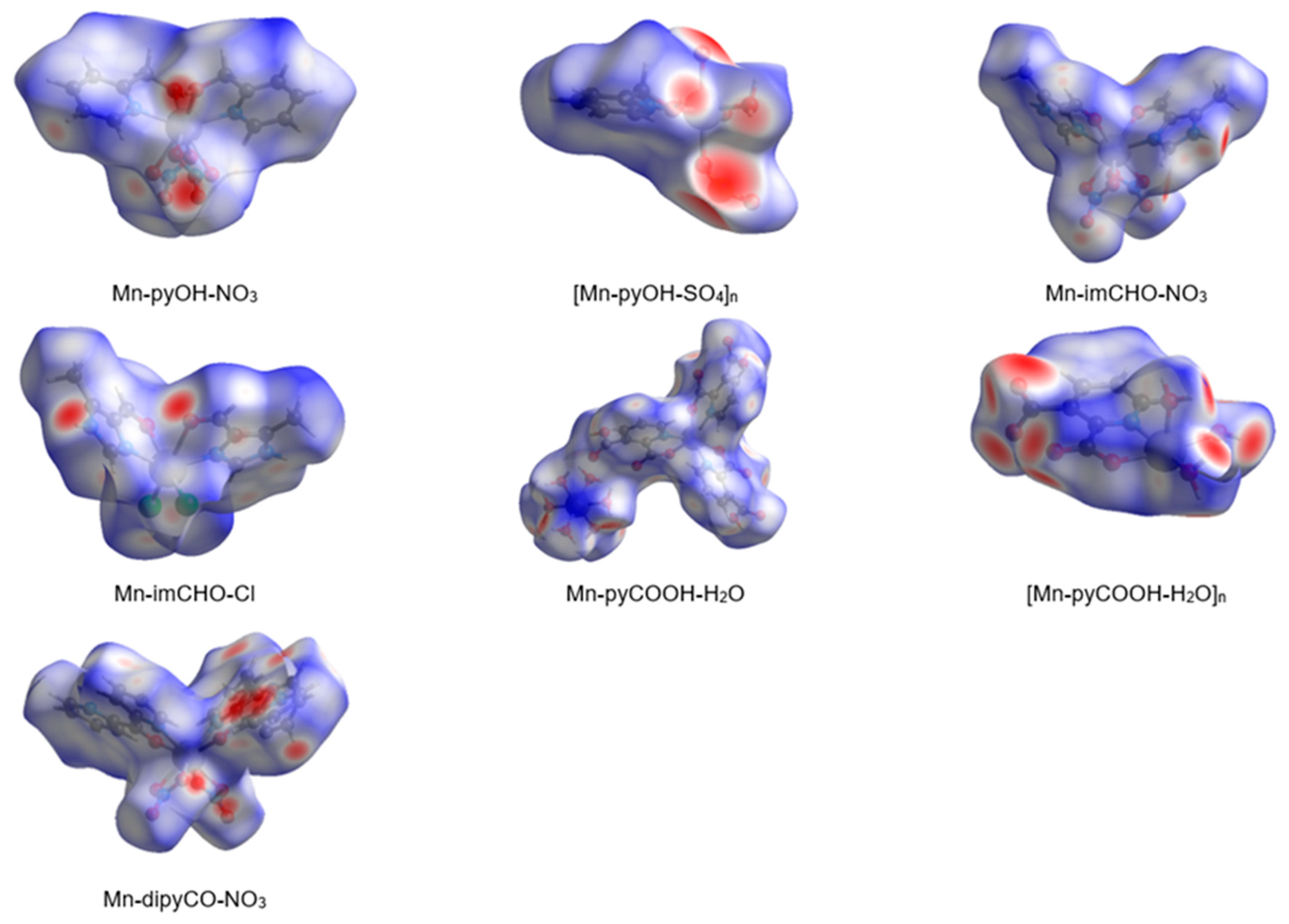
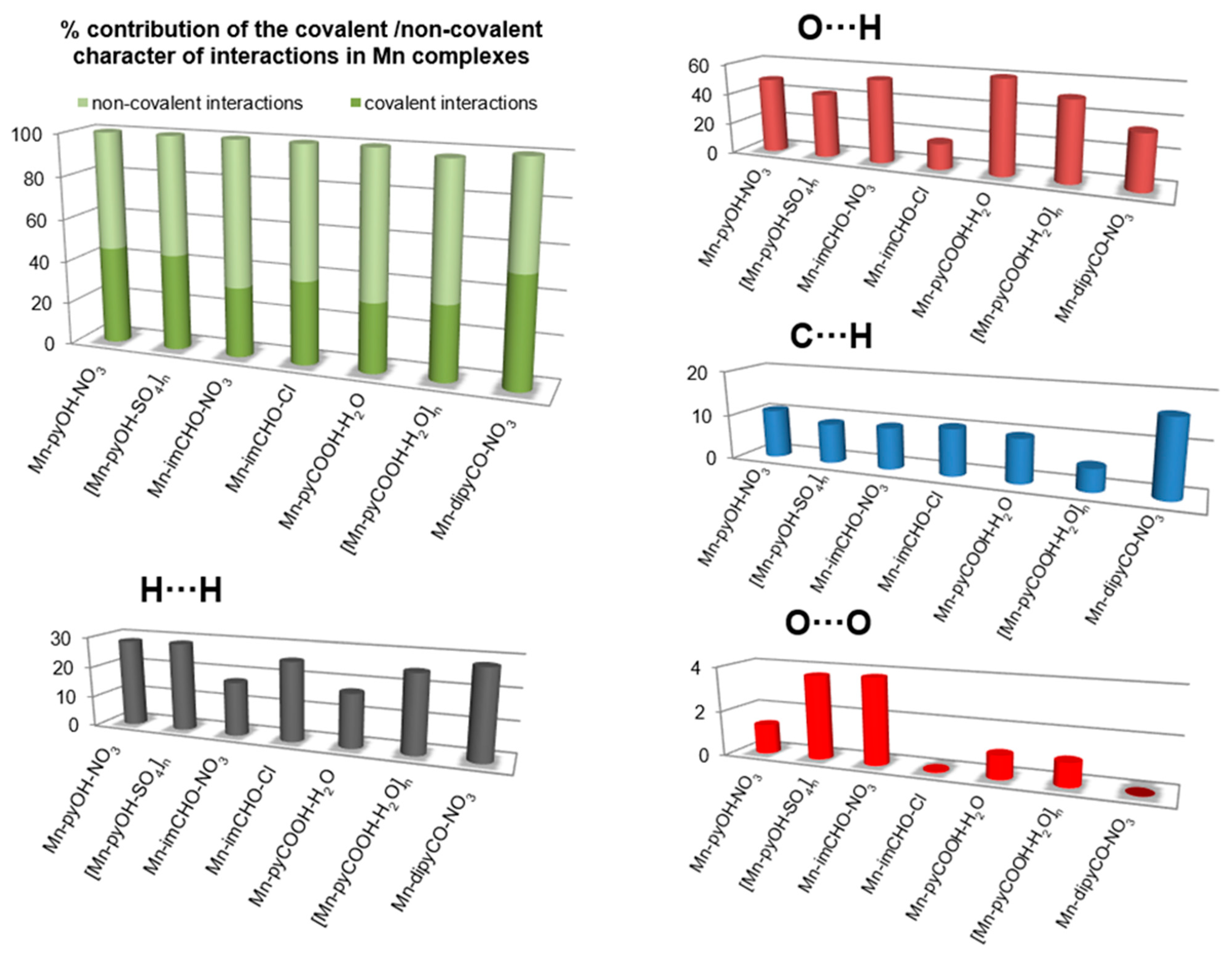



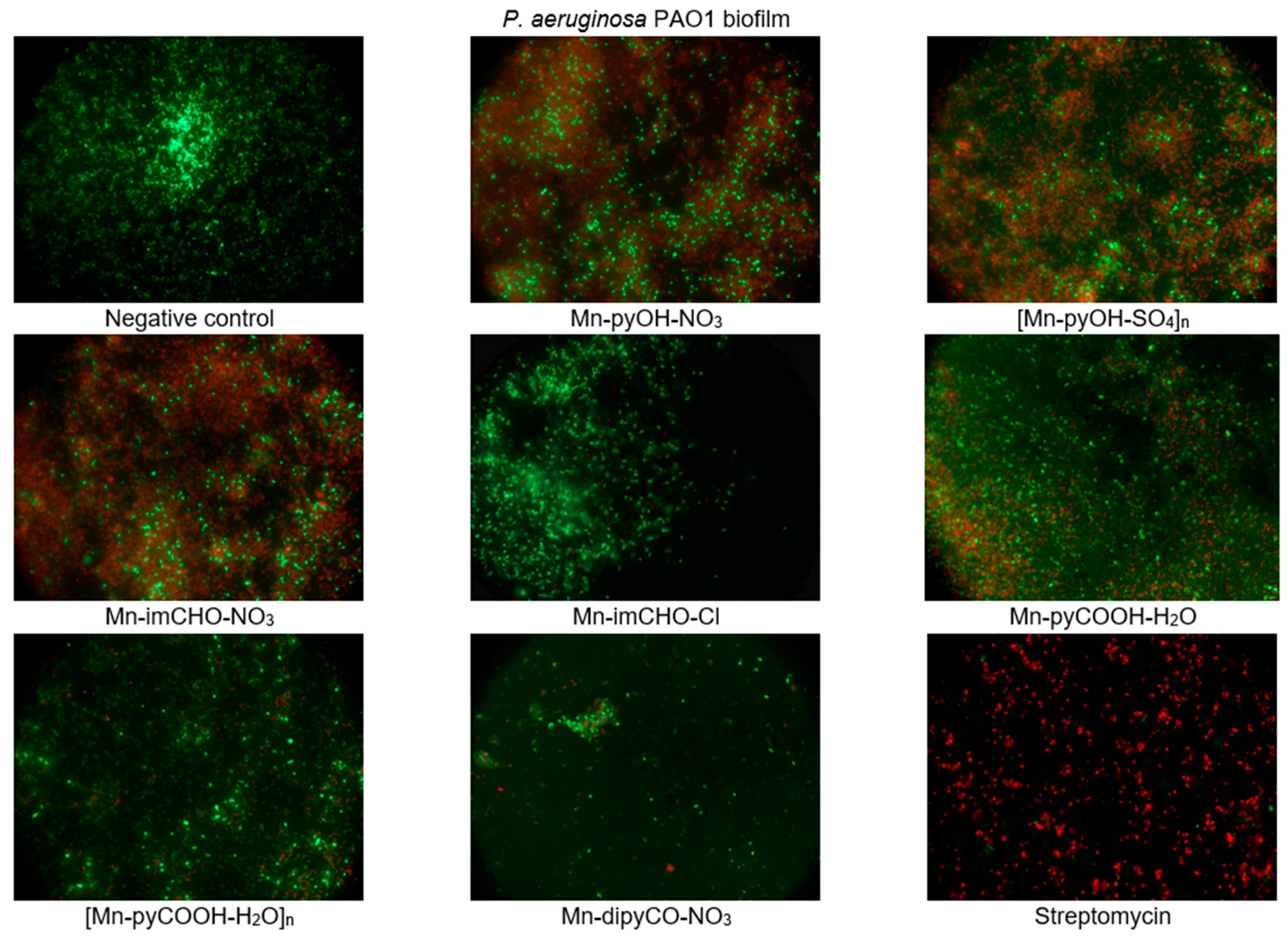
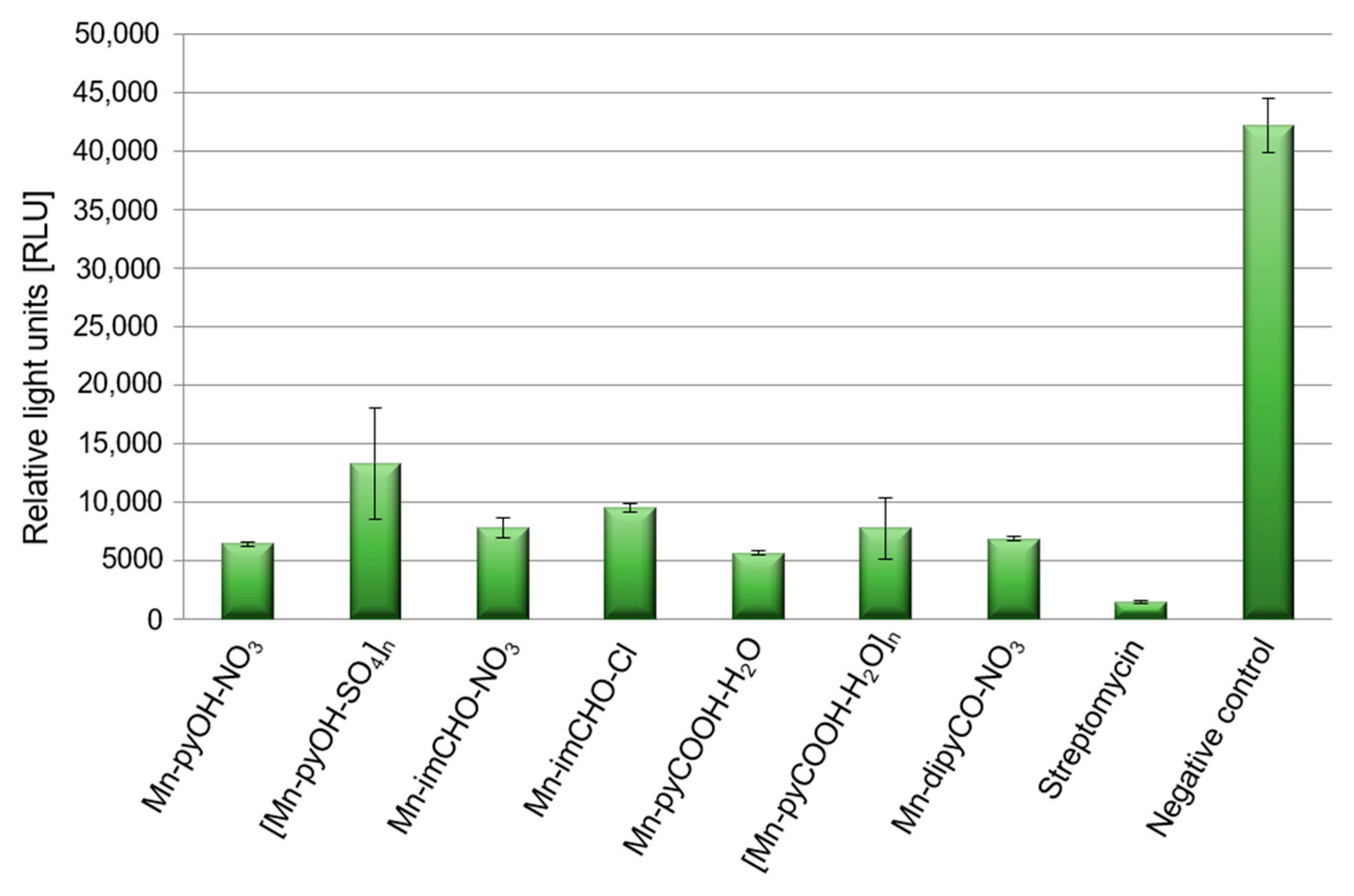
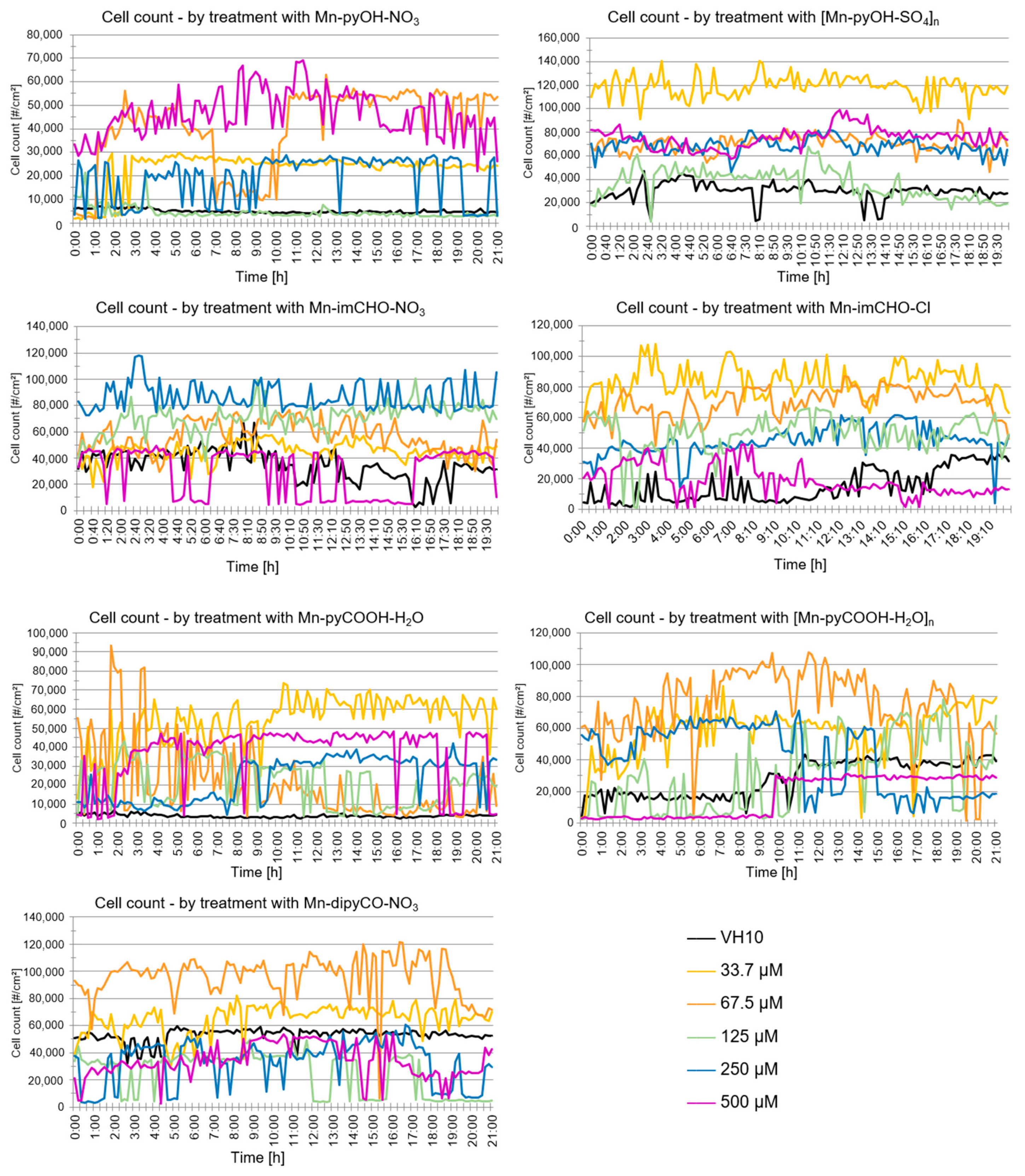
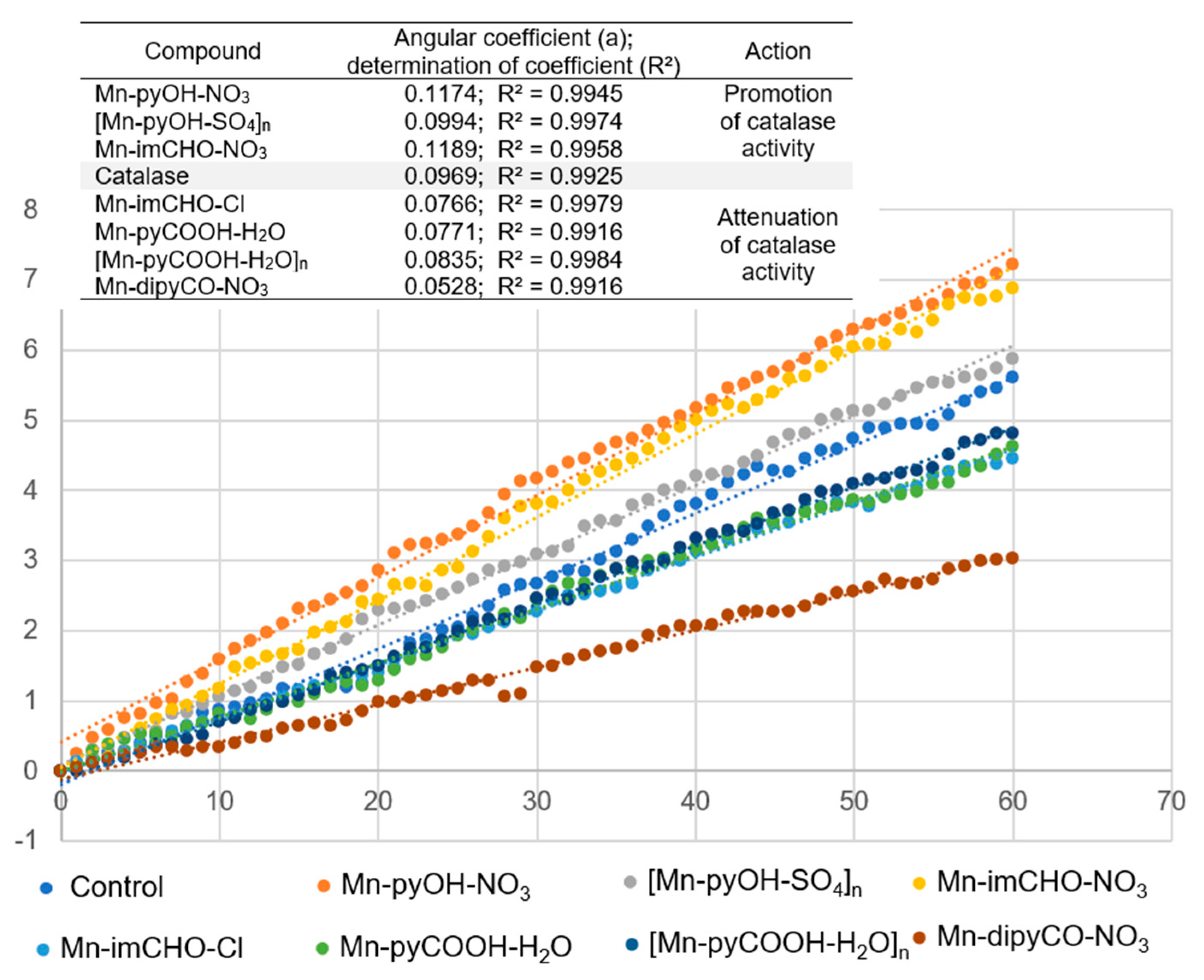
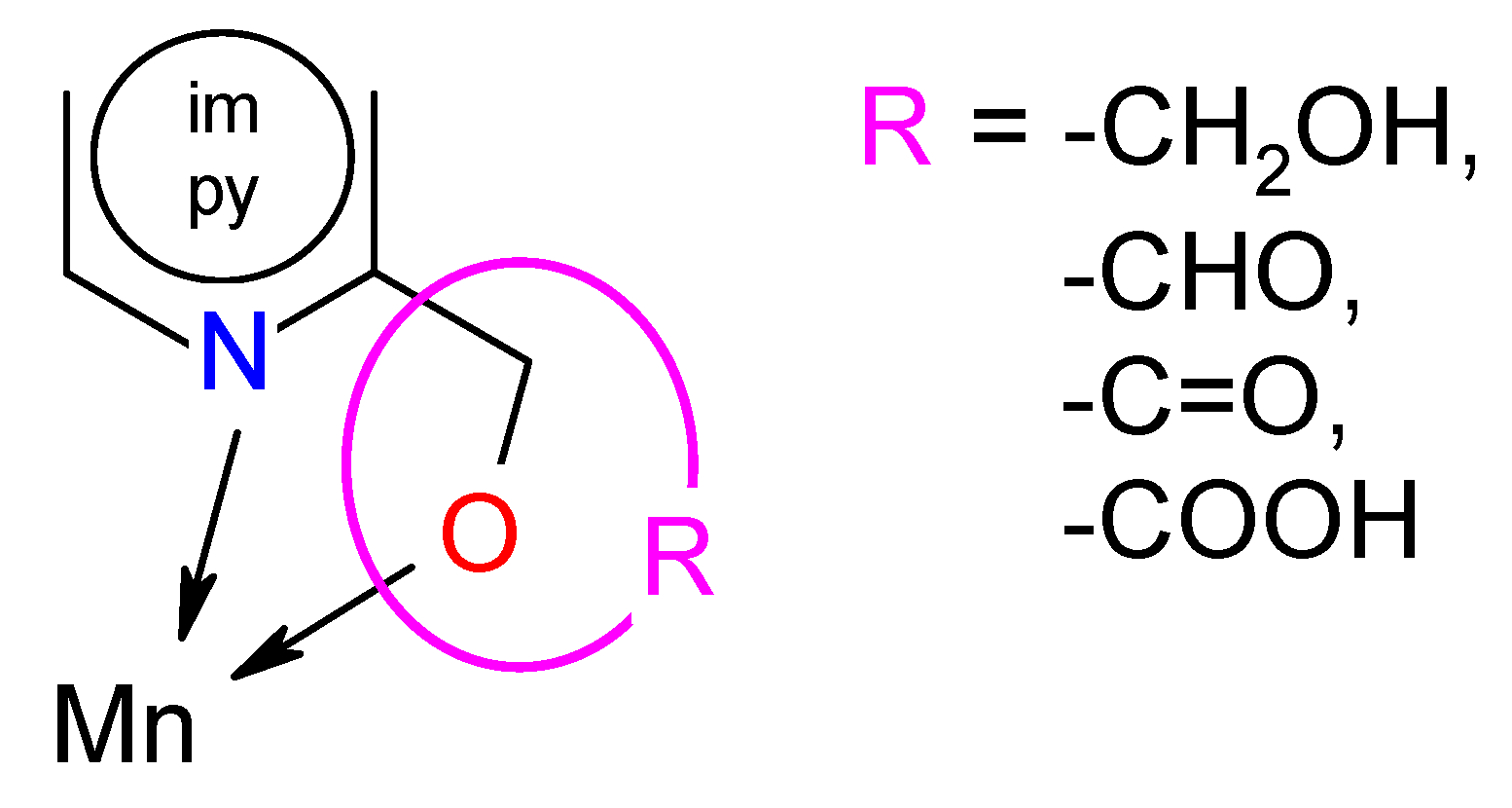

| Step | TG Range/K | DTG max/K | Mass Loss Obs. (Calcd.)/% | Assignment |
|---|---|---|---|---|
| I | 448–540 | 483 | 34.37 (32.93) | 0.98 dipyCO |
| II | 540–628 | 583 | 16.58 (16.81) | 2 NO2 |
| III | 628–1073 | 663 | 32.98 (34.38) | 1.02 dipyCO |
| Total | 83.93 (84.12) | Leaving MnO2 residue | ||
| Criteria |  |  | Bidentate Nitrate |
|---|---|---|---|
| l2-l1 | 0.07 | 0.14 | <0.3 [34] |
| A1-A2 | 2.78 | 6.33 | <14 [34] |
| l3-l2 | 0.37 | 0.33 | >0.2 [34] |
| A3 | 176.42 | 174.37 | >162 [34] |
| Complex | Mn-N (Ligand) [Å] | Mn-O (Ligand) [Å] | Space Group | ∠ N-C-C-O [°] | ∠ N-Mn-O Chelate [°] | ∠ O-Mn-O Chelate [°] | CN | % Inhibit. Biofilm (0.5 mM) | % Inhibit. Biofilm (0.25 mM) |
|---|---|---|---|---|---|---|---|---|---|
| Mn-pyOH-NO3 | 2.2792(1) | 2.2296(1) | C 2/c | 7.31 | 71.36 | 51.36 |  | 54 | 49 |
| [Mn-pyOH-SO4]n | 2.247(2) | 2.2325(2) | P 21/c | −26.23 | 72.37 | – |  | 53 | 48 |
| Mn-imCHO-NO3 | 2.2185(1) 2.2250(1) 2.222 (avg.) | 2.3897(1)-2.4693(1) | P | −2.91 −0.30 | 71.4 672.67 72.07 (avg.) | 49.03 52.69 50.86 (avg.) |  | 56 | 52 |
| Mn-imCHO-Cl | 2.2254(2) 2.2319(2) 2.229 (avg.) | 2.3955(2) 2.5951(2) | P | −1.14 −0.31 | 69.41 72.58 71.00 (avg.) | – |  | 29 | 24 |
| Mn-pyCOOH-H2O | 2.2805(1) | 2.1390(1) | P | −14.22 | 74.13 74.09 (avg.) | – |  | 48 | 45 |
| [Mn-pyCOOH-H2O]n | 2.2630(4) | 2.137(3), 2.167(3) | P ca 21 | 2.88 | 74.72 | – |  | 45 | 44 |
| Mn-dipyCO-NO3 | 2.2715(2) 2.3180(2) 2.295(avg.) | 2.3144(2) 2.3049(2) | P | −3.14 −3.21 | 69.25 69.03 69.14 (avg.) | 54.34 55.19 54.77 (avg.) |  | 36 | 21 |
Publisher’s Note: MDPI stays neutral with regard to jurisdictional claims in published maps and institutional affiliations. |
© 2021 by the authors. Licensee MDPI, Basel, Switzerland. This article is an open access article distributed under the terms and conditions of the Creative Commons Attribution (CC BY) license (https://creativecommons.org/licenses/by/4.0/).
Share and Cite
Jabłońska-Wawrzycka, A.; Rogala, P.; Czerwonka, G.; Michałkiewicz, S.; Hodorowicz, M.; Gałczyńska, K.; Cieślak, B.; Kowalczyk, P. Tuning Anti-Biofilm Activity of Manganese(II) Complexes: Linking Biological Effectiveness of Heteroaromatic Complexes of Alcohol, Aldehyde, Ketone, and Carboxylic Acid with Structural Effects and Redox Activity. Int. J. Mol. Sci. 2021, 22, 4847. https://doi.org/10.3390/ijms22094847
Jabłońska-Wawrzycka A, Rogala P, Czerwonka G, Michałkiewicz S, Hodorowicz M, Gałczyńska K, Cieślak B, Kowalczyk P. Tuning Anti-Biofilm Activity of Manganese(II) Complexes: Linking Biological Effectiveness of Heteroaromatic Complexes of Alcohol, Aldehyde, Ketone, and Carboxylic Acid with Structural Effects and Redox Activity. International Journal of Molecular Sciences. 2021; 22(9):4847. https://doi.org/10.3390/ijms22094847
Chicago/Turabian StyleJabłońska-Wawrzycka, Agnieszka, Patrycja Rogala, Grzegorz Czerwonka, Sławomir Michałkiewicz, Maciej Hodorowicz, Katarzyna Gałczyńska, Beata Cieślak, and Paweł Kowalczyk. 2021. "Tuning Anti-Biofilm Activity of Manganese(II) Complexes: Linking Biological Effectiveness of Heteroaromatic Complexes of Alcohol, Aldehyde, Ketone, and Carboxylic Acid with Structural Effects and Redox Activity" International Journal of Molecular Sciences 22, no. 9: 4847. https://doi.org/10.3390/ijms22094847
APA StyleJabłońska-Wawrzycka, A., Rogala, P., Czerwonka, G., Michałkiewicz, S., Hodorowicz, M., Gałczyńska, K., Cieślak, B., & Kowalczyk, P. (2021). Tuning Anti-Biofilm Activity of Manganese(II) Complexes: Linking Biological Effectiveness of Heteroaromatic Complexes of Alcohol, Aldehyde, Ketone, and Carboxylic Acid with Structural Effects and Redox Activity. International Journal of Molecular Sciences, 22(9), 4847. https://doi.org/10.3390/ijms22094847





